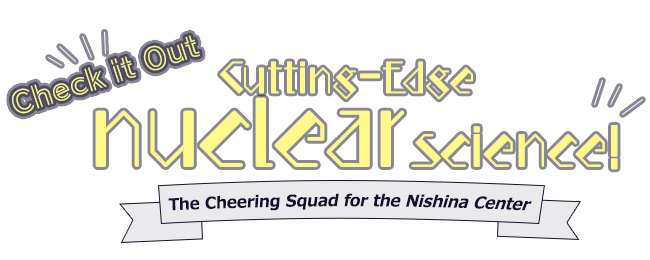
‘We get to handle elements that don’t normally exist’
Two researchers conducting cutting-edge radioisotope research were a senior and a junior at the same university in their student days.
Interview with Dr. Yudai Shigekawa and Dr. Akihiro Nambu, RI Application Research Group
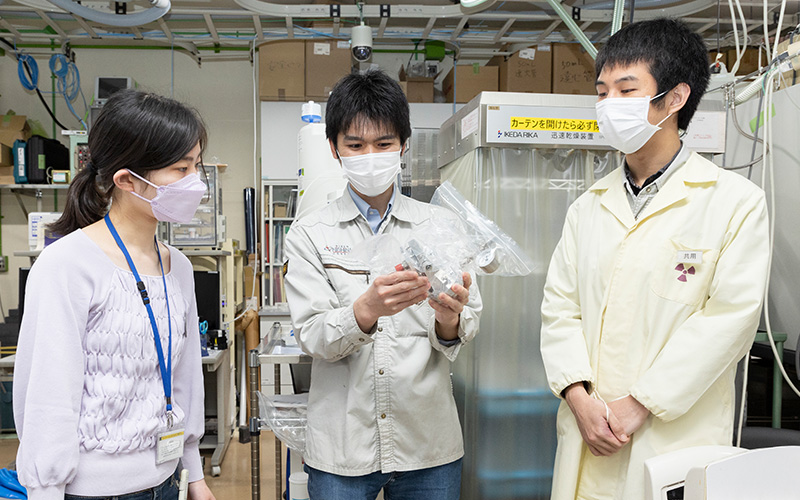
What kind of research is being done by the RI Application Research Group?
The RI Application Research Group, one of the few chemistry departments at the Nishina Center, conducts research on radiochemistry. They produce radioisotopes (RIs) and chemically separate them to investigate their properties, apply them to various fields including medicine, and provide them to other research institutions. Among RIs, superheavy elements have a particularly short half-life and only a single atom can be handled at a time. The superheavy elements the accelerator produces are transported to the laboratory directly above the accelerator in about one second for rapid chemical manipulation, and researchers observe their behavior.
Biographies of the two researchers:
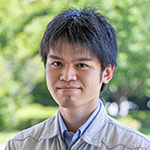
Completed the doctoral course at Osaka University’s Department of Chemistry, Graduate School of Science, in 2019. After working as a Postdoctoral Researcher at the Nishina Center, he became a Research Fellow at the Nishina Center in 2022. His hobby is reading manga comic books.
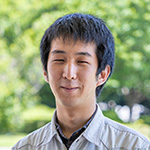
Completed the master’s course at Osaka University’s Department of Chemistry, Graduate School of Science, in 2018. After working as a teacher at Sayamagaoka High School in Saitama, Japan, he became a technical staff member of the Nishina Center in 2020. His hobby is making pudding.
“I was so surprised when Nambu-san came to RIKEN!” Dr. Shigekawa said. Dr. Nambu was Dr. Shigekawa’s junior in the same laboratory at the university. The two, who study RI together, are a perfect match.
Q1What are your favorite elements, and what draws you to radiochemistry?
Shigekawa: My attraction is to elements that I have used in my research, such as thorium (Th), uranium (U), and plutonium (Pu), which are well known for their use as nuclear fuel. They have various isotopes, and I studied uranium-235 (235U) at university.
Nambu: I am also attracted to Th, which I have been using a lot in my recent experiments, and from Th, I am trying to create actinium-225 (225Ac), which can be used as a raw material for pharmaceuticals.
Shigekawa: The appeal of radiochemistry is the feeling of mixing physical measurement and chemical separation to figure things out, and the heterogeneity of being able to handle all the elements in the periodic table, including radioactive materials that you cannot normally handle. The famous scientist Marie Curie made her breakthroughs after she separated radioactive materials from several tons of minerals. Maybe we’re doing a similar thing, though with different technology.
Nambu: I have a special feeling for it, as this is different from ordinary chemistry. Many people in the field of radiochemistry are motivated to do very special things.
Shigekawa: Because we use dangerous radioactive materials, we have to conduct experiments in controlled areas. Since they cannot be handled in an ordinary laboratory, there are very few laboratories at universities that offer radiochemistry as a main discipline, thus the field is not well known among young students.
Shigekawa and Nambu: This is why we want many more people to be interested in the field.
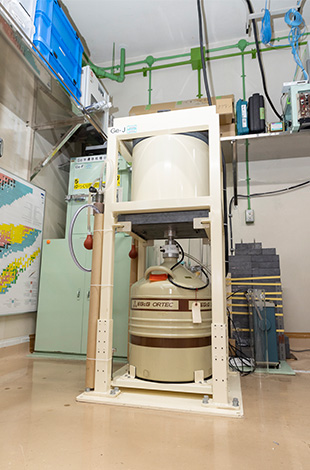
A Germanium (Ge) detector, which detects radioactive substances present in samples.
Q2What are your favorite books?
Shigekawa: I read a lot of science books, and I especially like “Quantum” by Manjit Kumar, because it explains the history of quantum mechanics. It is a dramatic tale about how quantum mechanics developed and “the moment a science was born.” I hope I can witness the birth of a new science, too.
Nambu: When I was in junior high and high school, I often read the Blue Backs series. I especially liked “Relativity for The Layman” by James A. Coleman. At university, I was in the chemistry department, but since I was originally interested in physics as well, I often attended lectures in the physics department.
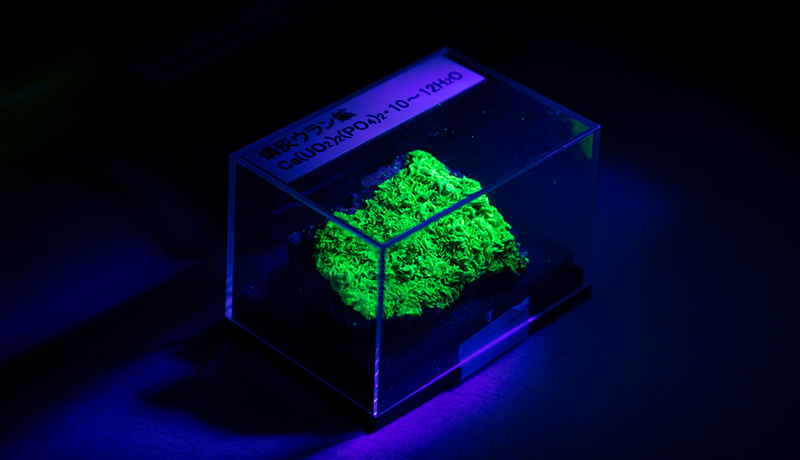
Minerals containing uranium glow when exposed to black light.
Q3Dr. Nambu, I hear you were a high school teacher for two years.
Nambu: One of my parents was a teacher, so when the time came to think about starting work, I decided to get a teaching license. The difference is that a teacher works largely for the benefit of others, while a researcher is motivated by his or her own curiosity. But of course, researchers are also motivated by how they could contribute to the world and others as well. As a teacher, I mainly taught chemistry, but because I had to teach everything in the textbooks, I acquired knowledge in a wide variety of fields. This knowledge is useful when I want to do something new in my research and need to combine or bring together different facets of my knowledge.
Shigekawa: High school knowledge can be surprisingly useful.
Nambu: Textbooks are important.
Shigekawa: It is difficult to apply what you’ve learned unless you have the habit of actually thinking about it in the field. That’s why whenever we have trouble with an experiment, we discuss what the problem is.
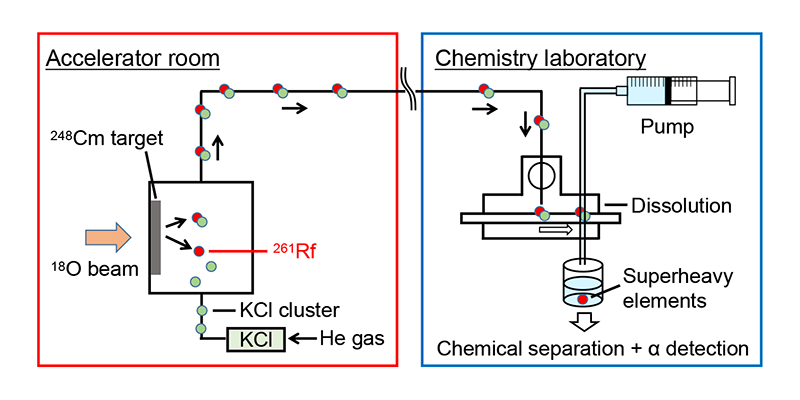
Flow from the synthesis of superheavy elements to their chemical separation.
Q4What do you do to relax from your research?
Shigekawa: Nothing extraordinary, just sweets and coffee. A break from desk work is essential.
Nambu: The two of us have discussions, talk about unrelated topics, or watch the news. I also enjoy the view of a pond and rows of cherry trees within the RIKEN campus where I often ride my bicycle. It’s one of my favorite spots at RIKEN. Sometimes you can even see ducks.
Shigekawa: I take walks for a change of scenery. Before the COVID-19 pandemic, there were many people viewing the cherry blossoms. Now, there are not many people walking around, but RIKEN is rich in nature and the atmosphere is similar to that of a university campus.
(Interviewed in April, 2022)
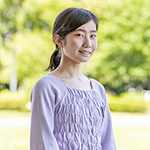
After the interview
They were both very kind and I could feel the close relationship and bond between them during the interview. I really enjoyed the tour of the facility, which is not ordinarily easily accessible. Until now, I did not have a clear image or idea about radiochemistry nor its research, but after interviewing them, I have found the field to be very appealing because all elements that have been discovered are the subject of research, and the field requires both physical and chemical thinking process. I appreciate Dr. Shigekawa and Dr. Nambu for taking their valuable time to speak with me.


 Superheavy Element Research Group
Superheavy Element Research Group Ion Beam Breeding Group
Ion Beam Breeding Group Nuclear Many-body Theory Laboratory
Nuclear Many-body Theory Laboratory Instrumentation Development Group
Instrumentation Development Group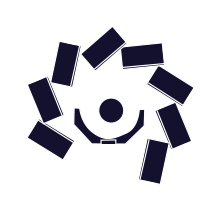 Radioactive Isotope Physics Laboratory
Radioactive Isotope Physics Laboratory Spin Isospin Laboratory
Spin Isospin Laboratory Nuclear Spectroscopy Laboratory
Nuclear Spectroscopy Laboratory Accelerator Basic Research Department
Accelerator Basic Research Department RI Application Research Group
RI Application Research Group